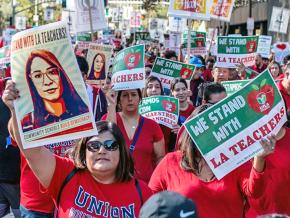LA teachers march toward the picket lines
reports from Los Angeles on a 50,000-strong march for teachers and public education while the union sets a strike date in the showdown with the district.
LOS ANGELES public school teachers are preparing for a showdown, with a strike date set for January 10 and a 50,000-strong march on December 15 to show they have the support of students, parents, community organizations and supporting unions.
In a year highlighted by struggles in red states like West Virginia and Arizona, where teachers organized actions spanning from wildcat walkouts to “sick-outs,” mass rallies and marches, LA teachers are getting ready for the fight of their lives.
Called by United Teachers Los Angeles (UTLA), the “March for Public Education” brought tens of thousands of people to downtown Grand Park. Viewed from above, the march was a seemingly endless sea of red, worn in solidarity with teachers, along with signs, union banners and noisemakers.
UTLA expected a turnout of 20,000, but that was far surpassed, largely through the efforts of person-to-person organizing at school sites, where teacher-activists were asked to keep count of the number of commitments among the union’s 33,000 members.

The march, comprised of teachers, students, parents, community organizations and supporting unions, served notice to both Austin Beutner, the Los Angeles Unified School District (LAUSD) superintendent, and Eli Broad, the billionaire pro-charter school advocate, that when educators go on strike next month, they’ll have plenty of support.
“If my teacher goes on strike, I’ll definitely be there to support him,” said Manuel, a 15-year-old student from the San Fernando Valley who attended the event with his parents. “[The district] needs to devote more money to the students, because our schools need the help now, not later. I get sick of being in crowded classes, and not always being able to have enough books.”
REINVESTING IN public education was a major theme reiterated throughout the event, along with other demands that include smaller class sizes, better pay for teachers, hiring more nurses and counselors, and an end to random searches.
These issues came up repeated in speeches by pre-march speakers and marchers’ slogans raised during the trek from the park to The Broad — Eli Broad’s contemporary art museum, located a short distance from Grand Park.
The pro-charter and privatization efforts being led by the likes of Beutner and Broad weren’t lost on people in the crowd. Throughout the march, slogans such as “Money for kids and education, not for billionaire profit-making!” and “Privatizers, take a hike! Education is a right!” helped to drive home the point.
UTLA President Alex Caputo-Pearl spoke to how resources should be allocated during the pre-march rally:
We’re here, because amidst the wealth of Los Angeles, we should not have class sizes of 45 students. We shouldn’t have 80 percent of our schools not have a full-time nurse. We’re here today, because we want reinvestment in our neighborhood schools. We don’t want downsizing and privatizing led by an investment banker-superintendent.
Francisca, an LAUSD parent, said she attended the event because she’d like to see smaller class sizes. Currently, she said, class sizes only increase as students move on to the next grade level.
Asked about a potential strike, Francisca said teachers had her support, but that she was concerned about how lengthy it would be. She plans to take her kids out of school during the strike.
THE MARCH came after nearly 20 months of negotiations between UTLA and the LAUSD, in which the district has shown that it’s unwilling to bargain in good faith.
In August, UTLA members voted overwhelmingly to authorize a strike should LAUSD’s offers not be sufficient. On December 19, UTLA announced a strike date of January 10.
In its press release, the teachers’ union cited the findings of a neutral fact-finding report released that week that confirmed major union positions: “That LAUSD has $1.8 billion in reserves (total is now $1.9 billion); that LAUSD should increase staffing of nurses, counselors and other professional staff; and that LAUSD should eliminate Section 1.5 of the contract (which allows the district to unilaterally increase class size).”
Salaries for teachers and staff haven’t come close to keeping up with the increase in the cost of living in one of the most expensive states in the country, and this has helped create a teacher shortage that denies teachers and students the conditions they deserve for quality education.
Yet LAUSD claims it doesn’t have the money to meet teachers’ demands for more resources and smaller class sizes.
The district is employing a “broke-on-purpose” scheme, which has become a hallmark for privatization ploys throughout the nation the past several years, in an effort to defund public education and hand it over to the private sector.
The fact is that LAUSD district is sitting on nearly $2 billion in reserves. Also, on a yearly basis, LAUSD diverts $600 million from public schools toward charter schools, according to Caputo-Pearl.
The scheme isn’t all that far-fetched when one takes a closer look at “school reform” advocates such as Broad, who, years ahead of the current teachers’ struggles, had already mapped out battle plans to defund and dismantle public education in favor of for-profit, private charter schools.
Nothing short of a collective, mass organized resistance led by teachers’ unions, along with parents, students and other sectors of workers, will stop the attacks on public education.
The “red state” teachers’ rebellion this past spring, along with the recent victory by charter school teachers in Chicago, are examples of how struggle can look.
“I came out today because there’s no separating these fights,” Jacqueline, who teaches at Manual Arts High School in South LA, said about demands for better teacher pay, smaller class sizes, and more nurses and counselors. “How can anybody survive in LA on what most, if not all of us are making these days? It’s time for people to stand up and say, ‘Enough.’”


